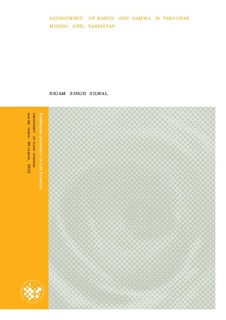Assessment of radon and gamma in Taboshar mining site, Tajikistan.
Master thesis
Permanent lenke
http://hdl.handle.net/11250/189539Utgivelsesdato
2012-09-20Metadata
Vis full innførselSamlinger
- Master's theses (IPM) [204]
Sammendrag
This thesis is based on results obtained by the joint effort of the NATO RESCA and the
JNKKT projects, carrying out field work in the former mining site in Taboshar, Tajikistan.
The uranium legacy from mining operations of the former USSR nuclear weapons program,
results in high background radiation. The mining site includes an open pit lake, low grade
radioactive materials, and tailing piles. The objective of the theses was to estimate average
annual gamma and radon doses to the public.
The measurements of in situ gamma dose rates and radon concentrations were obtained from
the summary report from the joint RESCA and JNKKT projects. The joint field work was
performed in the year 2008, and radon and gamma measurements were taken simultaneously
at the same point. Both active and passive radon detector were used to measure radon
concentrations in air, while different dosimeters were used to measure gamma radiation dose
rates. All the measurements were performed at 1 m above the ground level. After the exposure
period, analysis of the Rn detectors was carried out in Slovenia and in Norway. Windows
Office Excel 2007 and Minitab 16 were used for the analysis of data.
Annual effective gamma doses were calculated using dose conversion factor 1 Sv/Gy and
occupancy time of 6000 hrs/y for indoor environment, 2000 hrs/y for public buildings, 200
hrs/y for hospital and spa, 350 hrs/y for tailing repository and pit lake, and 700 hrs/y for
gardens of houses. Radon doses were calculated using conversion factor of
9nSv/Bq/m3/hr.The equilibrium factor used was 0.4 for indoor and 0.5 for outdoor radon.
Furthermore, dose from uranium in drinking water was also calculated based on the U
concentration (38.9 μg/L) and assuming an average drinking water consumption of 730 L/y.
All the doses were added to calculate the total annual dose which was used to estimate risk.
Risk factor of 0.05 per Sv for fatal cancer and 0.057 per Sv for serious health effects were
used.
The measured gamma dose rates were: Tailing repository (0.5 – 1.6 μGy/h), Pit lake (0.42 –
1.5 μGy/h), School (0.1 – 1.3 μGy/h). Accordingly, the calculated annual effective doses due to gamma radiation were Tailing repository (0.18 – 0.56 mSv), Pit lake 0.15 – 0.53 mSv) and
school (0.2 – 2.6 mSv).
The measured radon concentrations showed wide variations: Quarry (120 – 900 Bq/m3),
Hospital (80 – 1440 Bq/m3) and School (90 – 1420 Bq/m3). However, the calculated average
concentrations were found to be: Quarry (462 ± 309 Bq/m3), Hospital (560 ± 763 Bq/m3) and
School (429 ± 455 Bq/m3). Accordingly, the calculated average radon doses to humans in
Taboshar were: Quarry (0.58 ± 0.4 mSv), Hospital (0.4 ± 0.5 mSv) and School (3.1 ± 3.3
mSv).
Pearson correlation was performed between radon concentrations and gamma dose rates to
find if any relationship existed. The correlation was moderate (p<0.05) and indicated that the
gamma dose rates increased with increased radon concentrations. The calculated annual
effective dose from drinking water was 0.04 – 1.04 mSv. The total annual dose calculated for
public exposure from all the radiation along with exposure from drinking water amounted to
7.534 mSv. The risk factor of ICRP (2007) was used to calculate risk and based on the
estimated population of 14000, the risk found reflected the probability of 5 cancerous disease
and 6 serious health disease cases in a year.
Most of the sites studied in Taboshar mining site were found to have higher gamma dose rates
than global average corresponding. The outdoor gamma dose rate 0.42 – 1.6 μGy/h and
indoor gamma dose rate was 0.1 – 1.3 μGy/h. Similarly outdoor radon concentrations was 120
- 900 Bq/m3, and indoor radon concentration 80 – 1440 Bq/m3. The annual effective doses
due to outdoor gamma (0.15 – 0.56 mSv) and indoor gamma (0.2 – 2.6 mSv) were similarly
to those from outdoor radon (0.14 – 1.13 mSv) and from indoor radon (0.06 – 10.2 mSv). The
total dose of 7.53 mSv was estimated to be received from by all the population which is below
the reference value of ICRP. The risk of cancer disease is 5 and for acute health effect is 6. It
is therefore recommended that simple counter measures should be implemented at specific
sites to lower the exposure from ionizing radiation.
